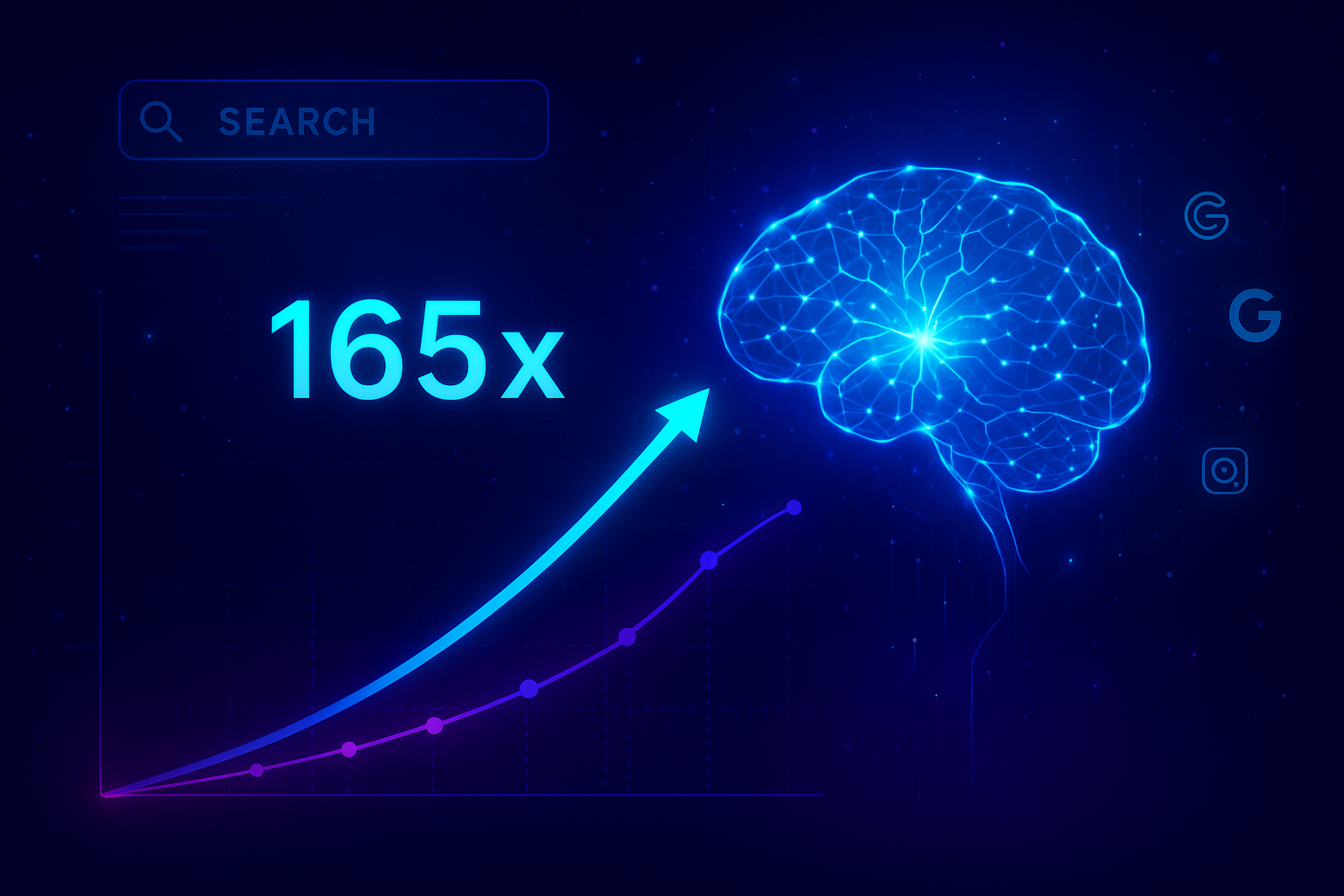Gen AI’s 165× Faster Growth Over Organic Signals | A Shift in Search
We’re witnessing a tectonic shift in how people find things online. Whereas organic search signals (traditional SEO, link building, content marketing have long dominated the discovery landscape, generative AI is surging ahead, reportedly 165× faster in growth over organic signals. That number sounds dramatic, but it captures an essential transformation in search: AI is no longer just “another channel”, it’s becoming the channel for discovery, curation, and interaction.
Gen AI’s Meteoric Growth: A 165× Surge
What does “165× faster” really mean? It suggests that generative AI adoption (in queries, content generation, and AI-assisted search sessions) is compounding at a rate many times higher than organic signal growth (e.g., keyword increments, search volume increases, and backlink accrual). In practical terms, an industry that would need years of incremental SEO gains might now see comparable velocity via an AI platform in months. To put it in perspective: generative AI usage jumped from 33 % in 2023 to 71 % in 2024, reflecting how fast businesses are embracing these tools. And globally, 78 % of organizations now use AI in at least one role or function. (netguru.com) This overwhelming momentum is nudging search strategies from “optimize for Google/Bing” toward “optimize for AI discovery.”AI vs. Organic: Quantity vs. Quality?
One key tension arises: quantity versus quality. Traditional organic SEO tends to favor depth, niche authority, topic coverage, and consistent long-tail content. Generative AI, meanwhile, thrives on volume, adaptability, schema, prompts, and leveraging signals that feed into AI models. The risk? A flood of shallow or templated AI content is crowding out thoughtful, authoritative content. Yet the ideal is bridging both: high-quality content that is also AI-aware and structured for discovery. That’s where new frameworks like OmniSEO™ come in (we’ll get there soon).Platform Share of Gen AI Sessions
As generative AI matured, several platforms are competing for “search mindshare”:- ChatGPT/OpenAI ecosystem has surged in adoption, becoming a default assistant or search companion for many.
- Google’s Gemini/AI Overviews now embed AI summaries atop traditional search, turning many queries into zero-click interactions.
- Niche and domain-specific AI tools (e.g., Perplexity, Claude, Bing Copilot) capture vertical or workflow use cases.
Which Industries Are Leading in Gen AI Adoption?
Not all sectors are equal in riding this wave. Some verticals are leaping ahead:- Technology & Software/SaaS: Natural early adopters, both in use and production.
- Marketing/Media/Publishing: Content creation and discovery are core to their workflows.
- Professional Services (Legal, Consulting, Finance): For document drafting, answers, and insights.
- Retail/E-Commerce: AI assistants, recommendations, conversational search.
- Healthcare/Life Sciences: For knowledge summarization and diagnostics assistance.
- One Compelling Macro Stat: Generative AI adoption among organizations rose from 33 % to 71 % in a single year (2023 → 2024). That implies every industry is now under pressure to adopt or be left behind.
Industry Month-Over-Month Growth in Gen AI Sessions
Although we currently do not have publicly published month-by-month breakdowns across all verticals, anecdotal evidence and vendor data suggest:- SaaS/tech verticals see 10–25 % month-over-month growth in AI-driven sessions early on
- Publishing/media often shows 5–15 % MOM growth once AI overviews and summarization features roll out
- Niche B2B verticals might start slower (2–8 %), but once a use case demonstrates ROI, the growth curve steepens
OmniSEO™: A Framework for the New Search Era
To succeed today, you need more than just the best SEO services. You require OmniSEO™, a comprehensive framework that integrates organic, AI, social, voice, and interaction analytics into one cohesive strategy.What does OmniSEO™ involve?
OmniSEO™ is about orchestrating across four pillars:- Organic SEO
- AI Optimization
- Social & Voice Discovery
- AI Interaction Analysis
1. Organic SEO
This remains foundational. You still need:- Keyword research
- Topical authority and cluster content
- High-quality backlinks
- On-page optimization (titles, meta, headings, internal links)
2. AI Optimization
This is the new layer:- Schema markup (JSON-LD, AI, or LLM hint markup)
- AI-friendly metadata/prompts
- Tagging content to be “AI discoverable”
- Ensuring your content can be parsed, referenced, and summarized by LLMs
3. Social & Voice Discovery
Don’t assume search is the only interaction path:- AI-powered snippets are often fed from your social content or voice transcripts
- Voice assistants and smart displays may surface your content
- Social prompts or quoting your content may amplify AI visibility
4. AI Interaction Analysis
You must observe how users interact with AI outputs:- Which AI citations (from your content) actually lead to clicks?
- Which AI prompts lead to follow-up queries or conversions?
- How often is your content appearing in AI session contexts (impressions) vs actual traffic?
How to Optimize for Gen AI Discovery
Here’s a tactical roadmap to optimize for generative AI discovery, complementing your organic SEO work and aligning with artificial intelligence solutions.1. Test Your Brand In AI Platforms
- Query common brand and product names in ChatGPT, Gemini, Claude, and Perplexity
- See how your content or brand is referenced (if at all)
- Use prompt engineering to examine discoverability
2. Close AI Content Gaps
- Identify queries or prompts your audience would ask that your content doesn’t answer
- Create mini “AI answer pages” (short, precise, schema-annotated)
- Use FAQs, prompt/response pairs, or structured Q&A blocks
3. Optimize with Schema Markup
- Use JSON-LD structured data (FAQ, QAPage, HowTo, Product)
- Add AI-hint markup if available (e.g., LLM reference metadata)
- Provide context and citation clarity so that AI models can properly source your content
4. Build Content That Helps
- Focus on utility, not fluff
- Use step-by-step guides, examples, data, and references
- Break content into modular, self-contained units (so AI can quote/snippet)
5. Track, Adjust, Repeat
- Monitor which pages are being referenced in AI sessions
- Use analytics to track AI → click conversions
- Adjust prompt/metadata, test new angles, refresh content

